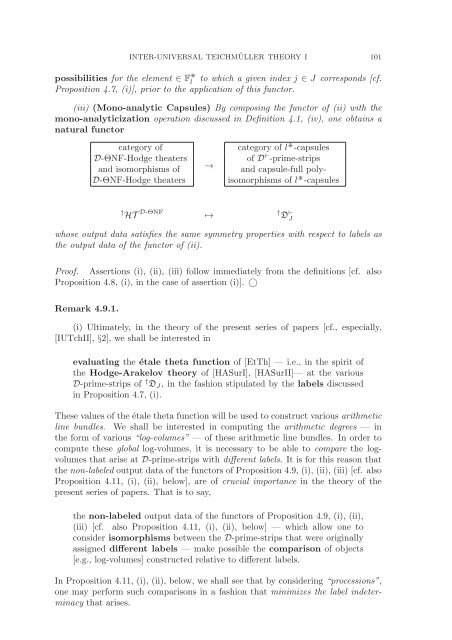Inter-universal Teichmuller Theory I: Construction of Hodge Theaters
Inter-universal Teichmuller Theory I: Construction of Hodge Theaters
Inter-universal Teichmuller Theory I: Construction of Hodge Theaters
Create successful ePaper yourself
Turn your PDF publications into a flip-book with our unique Google optimized e-Paper software.
INTER-UNIVERSAL TEICHMÜLLER THEORY I 101<br />
possibilities for the element ∈ F l<br />
to which a given index j ∈ J corresponds [cf.<br />
Proposition 4.7, (i)], prior to the application <strong>of</strong> this functor.<br />
(iii) (Mono-analytic Capsules) By composing the functor <strong>of</strong> (ii) with the<br />
mono-analyticization operation discussed in Definition 4.1, (iv), one obtains a<br />
natural functor<br />
category <strong>of</strong><br />
D-ΘNF-<strong>Hodge</strong> theaters<br />
and isomorphisms <strong>of</strong><br />
D-ΘNF-<strong>Hodge</strong> theaters<br />
→<br />
category <strong>of</strong> l -capsules<br />
<strong>of</strong> D ⊢ -prime-strips<br />
and capsule-full polyisomorphisms<br />
<strong>of</strong> l -capsules<br />
† HT D-ΘNF ↦→ † D ⊢ J<br />
whose output data satisfies the same symmetry properties with respect to labels as<br />
the output data <strong>of</strong> the functor <strong>of</strong> (ii).<br />
Pro<strong>of</strong>. Assertions (i), (ii), (iii) follow immediately from the definitions [cf. also<br />
Proposition 4.8, (i), in the case <strong>of</strong> assertion (i)]. ○<br />
Remark 4.9.1.<br />
(i) Ultimately, in the theory <strong>of</strong> the present series <strong>of</strong> papers [cf., especially,<br />
[IUTchII], §2], we shall be interested in<br />
evaluating the étale theta function <strong>of</strong> [EtTh] — i.e., in the spirit <strong>of</strong><br />
the <strong>Hodge</strong>-Arakelov theory <strong>of</strong> [HASurI], [HASurII]— at the various<br />
D-prime-strips <strong>of</strong> † D J , in the fashion stipulated by the labels discussed<br />
in Proposition 4.7, (i).<br />
These values <strong>of</strong> the étale theta function will be used to construct various arithmetic<br />
line bundles. We shall be interested in computing the arithmetic degrees —in<br />
the form <strong>of</strong> various “log-volumes” — <strong>of</strong> these arithmetic line bundles. In order to<br />
compute these global log-volumes, it is necessary to be able to compare the logvolumes<br />
that arise at D-prime-strips with different labels. It is for this reason that<br />
the non-labeled output data <strong>of</strong> the functors <strong>of</strong> Proposition 4.9, (i), (ii), (iii) [cf. also<br />
Proposition 4.11, (i), (ii), below], are <strong>of</strong> crucial importance in the theory <strong>of</strong> the<br />
present series <strong>of</strong> papers. That is to say,<br />
the non-labeled output data <strong>of</strong> the functors <strong>of</strong> Proposition 4.9, (i), (ii),<br />
(iii) [cf. also Proposition 4.11, (i), (ii), below] — which allow one to<br />
consider isomorphisms between the D-prime-strips that were originally<br />
assigned different labels — make possible the comparison <strong>of</strong> objects<br />
[e.g., log-volumes] constructed relative to different labels.<br />
In Proposition 4.11, (i), (ii), below, we shall see that by considering “processions”,<br />
one may perform such comparisons in a fashion that minimizes the label indeterminacy<br />
that arises.
















